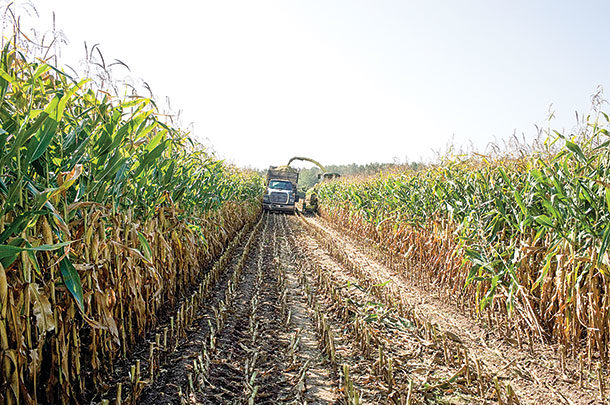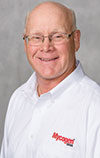We want to hit the “sweet spot” to ensure dairies take advantage of all the nutrient value and quality that comes from a properly harvested BMR crop. Harvest management helps growers obtain the digestibility and quality BMR hybrids with the bm3 gene are designed to deliver.
BMR hybrids require a close eye at harvest. BMR hybrids with the bm3 gene have one-third less lignin content in their stalks compared with other hybrids, making it easier for cows to digest and achieve higher milk production. It’s also more difficult to estimate BMR whole-plant moisture, requiring careful attention to chop length and kernel processing.
Hit the moisture strike zone
It’s important to chop BMR silage at the right moisture, neither too wet nor too dry. Silage harvested too wet may lose nutrients due to leaching. If harvested too dry, silage may lose valuable leaf material and may not ferment well.
To determine the ideal moisture, start scouting fields 33 to 35 days after tasseling and silking. Most hybrids usually reach maturity 40 to 45 days after full tassel, when the ear has developed and kernels are at half milkline.
Aim to harvest BMR between 65 and 68 percent whole-plant moisture, but don’t rely on “feel” to determine moisture levels for BMR hybrids. Take a sample from your field and use a Koster tester or microwave and do a drydown for accurate results.
Specific BMR moisture recommendations vary depending on storage practices. Suggested levels are as follows:
- Bunkers or piles: 66 to 70 percent
- Bags: 66 to 68 percent
- Top-loading, upright silos: 63 to 67 percent
It’s also important to see which fields are maturing most quickly and will need to be chopped first. Strategically planning harvest order can help you bring in more vital nutrients from each field.
Good silage needs correct theoretical length of cut
Correct theoretical length of cut (TLC) is an important factor to consider during BMR harvest.
Because BMR hybrids are more digestible, silage moves through the cow’s digestive system more quickly. That’s why we recommend a longer theoretical length of cut for chopping BMR hybrids – usually about 1 inch – to aid rumen function and slow rate of passage.
Discuss the recommended theoretical length of cut with your nutritionist, who is familiar with your ration and your cows.
Don’t get behind the curve
A common mistake is harvesting BMR silage after it’s too dry, which negatively impacts the fermentation process. As starch gets drier, it becomes harder and more difficult to digest in the cow’s rumen. If there is one big “watch-out” for harvesting BMR, it’s to not let forage get too dry before chopping.
Kernel processing is another key to producing good BMR silage. A well-maintained processor will deliver consistent particle size. When kernel particles are too large, they can pass through the animal undigested, which lowers the effective available energy in the diet.
However, keep in mind BMR kernels tend to be softer, and processor rolls may not need to be adjusted as tightly. Check with your nutritionist for BMR processing guidelines.
Most processing systems do a wonderful job if they are properly operated and maintained. Be mindful of the equipment manufacturer’s recommendations, but also ensure the chopper operator or custom operator monitors and evaluates corn continually during chopping.
As you move field to field or hybrid to hybrid, adjust processing and operation speeds to get the results you want.
Here’s a tip to check kernel processing: Take a 32-ounce plastic drinking cup, fill it with the chopped silage and dump it on a smooth area such as a large sheet of paper. Examine the processing you’re getting. Kernels should be broken in half or smaller.
According to Limin Kung of the University of Delaware, more than 95 percent of kernels should be cracked, with 70 percent equal to or smaller than one-third to one-fourth the kernel size. Continue to monitor every few passes.
Strategies to improve storage
Silage storage is like a closer on a baseball team, preserving the lead at the end of the game. Your storage system should preserve the high-quality nutrients the BMR crop produced in the field. Each type of storage requires specific management efforts.

With bunkers or piles, don’t deliver more silage than you can spread and pack effectively. Delivering silage faster than you can pack it will lead to poor fermentation and loss of nutritional value.
The University of Wisconsin has good data on how to calculate packing capabilities based on tractor weight. The combined weight of tractors packing the bunker should be at least 800 times the tons per hour delivered to the bunker.
For example, 50 tons of silage per hour delivered multiplied by 800 pounds tractor weight per ton of silage per hour delivered equals 40,000 pounds of tractor or packing equipment weight needed.
You can either add another tractor or slow down silage delivery for proper packing. However, it can be problematic to slow delivery when fields are at prime moisture level for harvesting.
Packing density also is important for towers, which depend on gravity and even silage distribution to get good uniform packing. With bags, monitor the pressure and pack the bag tightly to limit air and help facilitate fermentation.
BMR is a consistent hit
Growers increasingly are seeing BMR hybrids with the bm3 gene produce silage that delivers value to the entire operation. But to get the maximum benefit from BMR, be sure to develop a harvest game plan. Smart pre-harvest planning helps the dairy get the greatest nutritional impact and return on investment from these BMR hybrids. ![]()
PHOTO 1: Don’t get behind the curve when it comes to silage harvest. Build a harvest plan so you are ready to hit the fields when the crop is ready and to ensure you chop corn in each field at the ideal moisture.
PHOTO 2: Don’t stumble in the final inning. It is critical to properly pack and seal silage for a successful fermentation process. Create a game plan for silage delivery and have enough packing capacity available. Photos courtesy of Bill Sutliff.

-
Bill Sutliff
- Nutritionist
- Mycogen Seeds
- Email Bill Sutliff














